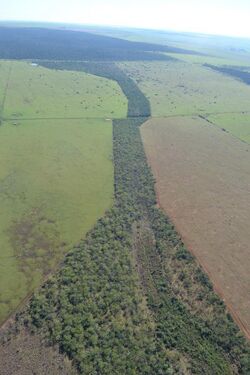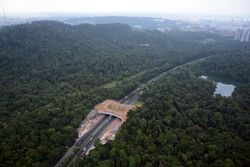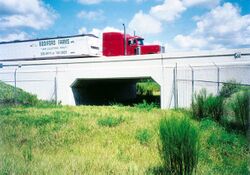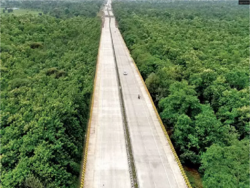Biology:Wildlife corridor
A wildlife corridor, habitat corridor, or green corridor[1] is an area of habitat connecting wildlife populations separated by human activities or structures (such as roads, development, or logging). This allows an exchange of individuals between populations, which may help prevent the negative effects of inbreeding, and reduced genetic diversity (via genetic drift) that often occur within isolated populations. Corridors may also help facilitate the re-establishment of populations that have been reduced or eliminated due to random events (such as fires or disease). This may potentially moderate some of the worst effects of habitat fragmentation,[2] whereas urbanization can split up habitat areas, causing animals to lose both their natural habitat and the ability to move between regions to access resources. Habitat fragmentation due to human development is an ever-increasing threat to biodiversity,[3] and habitat corridors serve to manage its effects.
Purpose
Habitat corridors can be considered a management tool in places where the destruction of a natural area has greatly affected native species, whether the result of human development or natural disasters. When areas of land are broken up, populations can become unstable or fragmented. Corridors can reconnect fragmented populations and reduce population fluctuations by contributing to three factors that can help to stabilize a population:
- Colonization—animals are able to move and occupy new areas when food sources or other natural resources are lacking in their core habitat.
- Migration—species that relocate seasonally can do so more safely and effectively when it does not interfere with human development barriers.
- Interbreeding—animals can find new mates in neighboring regions, increasing genetic diversity.
Rosenberg et al.[4] were among the first to define what constitutes a wildlife corridor, developing a conceptual model that emphasized the role of a wildlife corridor as a facilitator of movement that is not restricted by requirements of native vegetation or intermediate target patches of habitat.[5]
Wildlife corridors additionally have strong indirect effects on plant populations by increasing pollen and seed dispersal from animals, facilitating movement of disparate taxa between isolated patches.[6] Corridors must be large enough to support minimum critical populations, reduce migration barriers, and maximize connectivity between populations.[7]
Wildlife corridors may also encompass aquatic habitats (often called riparian ribbons[8]) and usually come in the form of rivers and streams. Terrestrial corridors can come in the form of wooded strips connecting woodland areas or an urban hedge.[7]
Users
Species can generally be categorized in one of two groups; passage users and corridor dwellers.
Passage users occupy corridors for brief periods of time. These animals use corridors for such events as seasonal migration, dispersal of a juvenile, or moving between parts of a large home range. Animals such as large herbivores, medium to large carnivores, and migratory species are passage users.[9]
Corridor dwellers can occupy the passage anywhere from several days to several years. Species such as plants, reptiles, amphibians, birds, insects, and small mammals can spend their entire lives in linear habitats. In this case, the corridor must provide sufficient resources to support such species.[9]
Types
Habitat corridors can be categorized according to their width, with wider corridors generally encouraging more use.[10] However, overall corridor quality depends more on design when creating an effective corridor.[7] The following are three divisions in corridor widths:
- Regional – (>500 metres (1,600 ft) wide); connect major ecological gradients such as migratory pathways.
- Sub-regional – (>300 metres (980 ft) wide); connect larger vegetated landscape features such as ridgelines and valley floors.
- Local – (some <50 metres (160 ft)); connect remnant patches of gullies, wetlands, ridge lines, etc.
Habitat corridors can also be divided according to their continuity. Continuous corridors are strips that are not broken up, while "stepping stone" corridors are small patches of suitable habitat. However, stepping stone corridors may be more susceptible to edge effects.
Corridors can also take the form of wildlife crossings, underpasses or overpasses used for crossing man-made feature such as roads, reducing human-wildlife conflict such as roadkill. Observations have shown that underpasses are actually more successful than overpasses because many times animals are too timid to cross over a bridge in front of traffic and would prefer to be more hidden.[11]
Monitoring use
Researchers can use mark-recapture techniques and hair snares in order to evaluate genetic flow to observe how a corridor is being used.[12] Marking and recapturing animals is more useful when keeping a close eye on individual movement.[13] However, tagging does not give any insight into whether the migrating individuals are successfully breeding with other populations.[citation needed]
Genetic techniques can be more effective when evaluating migration and mating patterns. By looking at a population's gene flow, researchers can understand the genetic consequences of corridors using information about the migration patterns of a population over time.[13]
Design
Wildlife corridors are most effective when they are designed with the ecology of their target species in mind. Additionally others factors like seasonal movement, avoidance behavior, dispersal, and habitat requirements can be considered.[14]
Generally, corridors are best built with a certain degree of randomness or asymmetry, and oriented perpendicular to patches.[15][7] Wildlife corridors are susceptible to edge effects; habitat quality along the edge of a habitat fragment is often much lower than in core habitat areas. Habitat corridors are important for large species requiring significant sized ranges; however, they are also vital as connection corridors for smaller animals and plants as well as ecological connectors to provide a ‟rescue effect’’.[16] Wildlife corridors is also expected to reduce human-wildlife conflicts. [17]
Examples
In Alberta, Canada, an overpass was constructed to keep animals off the busy highway which crosses a national park. The top of the bridge is planted with native grasses, and fences were put on either side to help guide animals.[18]
In Southern California, 15 underpasses and drainage culverts were observed to see how many animals used them as corridors. They proved to be especially effective on wide-ranging species such as carnivores, mule deer, small mammals, and reptiles, even though the corridors were not intended specifically for animals. Researchers also learned that factors such as surrounding habitat, underpass dimensions, and human activity also played a role in the frequency of usage.[19]
In South Carolina, five remnant areas of land were monitored; one was put in the center and four were surrounding it. Then, a corridor was put between one of the remnants and the center. Butterflies that were placed in the center habitat were two to four times more likely to move to the connected remnant rather than the disconnected ones. Furthermore, male holly plants were placed in the center region, and female holly plants in the connected region increased by 70 percent in seed production compared to those plants in the disconnected region. The most impressive dispersal into the connected region, though, was through bird droppings. Far more plant seeds were dispersed through bird droppings in the corridor-connected patch of land.[20]
There have also been positive effects on the rates of transfer and interbreeding in vole populations. A control population in which voles were confined to their core habitat with no corridor was compared to a treatment population in their core habitat with passages that they could use to move to other regions. Females typically stayed and mated within their founder population, but the rate of transfer through corridors in the males was very high.[21]
In 2001, a wolf corridor was restored through a golf course in Jasper National Park, Alberta, which successfully altered wildlife behavior by being frequently used by the wolves.[22][23]
Major wildlife corridors
- The Paséo Pantera (also known as the Mesoamerican Biological Corridor or Paséo del Jaguar)[24]
- The Eastern Himalayan Corridor[25]
- China-Russia Tiger Corridor[26]
- Tandai Tiger Corridor[27]
- The European Green Belt[28]
- The Siju-Rewak Corridor, located in the Garo Hills of India, protects an important population of elephants (thought to be approximately 20% of all the elephants that survive in the country). This corridor project links together the Siju Wildlife Sanctuary and the Rewak Reserve Forest in Meghalaya State, close to the India-Bangladesh border. This area lies within the meeting place of the Himalayan Mountain Range and the Indian Peninsula and contains at least 139 other species of mammals, including tigers, clouded leopards and the Himalayan black bear.[29]
- The Ecologische Hoofdstructuur is a network of corridors and habitats created for wildlife in the Netherlands[30]
- The 16 kilometres (9.9 mi) long Kanha-Pench elevated corridor on NH 44.[31]
- Two elephant passes and two minor bridges on NH 54 in Assam’s Lumding Reserve Forest.[32][33]
- Three elephant underpasses, each with 6 metres (20 ft) of vertical clearance on NH 72 and NH 58 in Uttarakhand, India.[34]
- Terai Arc Landscapes, Lower Himalayan Region.[35]
Evaluation
Some species are more likely to utilize habitat corridors depending on migration and mating patterns, making it essential that corridor design is targeted towards a specific species.[36][37]
There is usually a very limited amount of space available for corridors, so buffers are not usually added in.[4] Without a buffer zone, corridors can become affected by disturbances from human land use change. There is a possibility that corridors could aid in the spread of invasive species, threatening multiple populations.[38]
See also
- Aquatic organism passage
- Biolink zones
- Emerald network
- Habitat conservation
- Habitat destruction
- Landscape connectivity
- Marine Protected Area
- Natura 2000
- The Pollinator Pathway
- Roadkill
- Gary Tabor, wildlife corridor conservationist
- Tugay
- Wildlife crossing
- Yellowstone to Yukon Conservation Initiative
Further reading
- Beier, P., Noss, R.F. (December 1998). "Do Habitat Corridors Provide Connectivity?". Conservation Biology 12 (6): 1241–1252. doi:10.1111/j.1523-1739.1998.98036.x.
- Bennett, A.F. 1999. Linkages in the Landscape: The Role of Corridors and Connectivity in Wildlife Conservation. The World Conservation Union, Gland, Switzerland.
- De Chant, T. 2007. A Future of Conservation. Northfield Habitat Corridors Community Plan, Northfield, Minnesota.[39]
- Department of Environment and Conservation (DEC). 2004. Wildlife Corridors. DEC, New South Wales.
- Dole, J.W., Ng, S.J., Sauvajot, R.M. 2004. Use of Highway Undercrossings by Wildlife in Southern California. Biology Conservation, 115 (3):499-507. &Foreman, Dave. Rewilding North America: a Vision for Conservation in the 21st Century. Washington: Island, 2004.
- Fleury, A.M.; Brown, R.D. (1997). "A Framework for the Design of Wildlife Conservation Corridors with Specific Application to Southwestern Ontario". Landscape and Urban Planning 37 (8): 163–186. doi:10.1016/S0169-2046(97)80002-3.
- M., S. 2002. Ecology: Insects, Pollen, Seeds, Travel Wildlife Corridors. Science News, 162 (10):269.
- Mech, S.G.; Hallett, J.G. (2001). "Evaluating the Effectiveness of Corridors: a Genetic Approach". Conservation Biology 15 (2): 467–474. doi:10.1046/j.1523-1739.2001.015002467.x.
- Roach, J. 2006. First Evidence that Wildlife Corridors Boost Biodiversity, Study Says. National Geographic Society, Washington, D.C.[40]
- Rosenberg, D.K.; Noon, B.R.; Meslow, E.C. (1997). "Biological Corridors: Form, Function, and Efficacy". BioScience 47 (10): 667–687. doi:10.2307/1313208.
- Simberloff, D.; Farr, J.A.; Cox, J.; Mehlman, D.W. (1992). "Movement Corridors: Conservation Bargains or Poor Investments?". Conservation Biology 6 (4): 492–504. doi:10.1046/j.1523-1739.1992.06040493.x.
- Sutcliffe, O.L.; Thomas, C.D. (1996). "Open Corridors Appear to Facilitate Dispersal by Ringlet Butterflies (Aphantopus hyperantus) between Woodland Clearings". Conservation Biology 10 (5): 1359–1365. doi:10.1046/j.1523-1739.1996.10051359.x.
- Tewksbury, J.J.; Levey, D.J.; Haddad, N.M.; Sargent, S.; Orrock, J.L.; Weldon, A.; Danielson, B.J.; Brinkerhoff, J. et al. (2002). "Corridors Affect Plants, Animals, and Their Interactions in Fragmented Landscapes". PNAS 99 (20): 12923–12926. doi:10.1073/pnas.202242699. PMID 12239344. Bibcode: 2002PNAS...9912923T.
References
- ↑ "Planning Portal - Glossary: G". https://www.planningportal.gov.uk/england/professionals/en/1115310689250.html.
- ↑ Bond, M. (2003). "Principles of Wildlife Corridor Design. Center for Biological Diversity". Biologivaldiversity.org. http://www.biologicaldiversity.org/publications/papers/wild-corridors.pdf.
- ↑ Fahrig, Lenore (2003-11-28). "Effects of Habitat Fragmentation on Biodiversity" (in en). Annual Review of Ecology, Evolution, and Systematics 34: 487–515. doi:10.1146/annurev.ecolsys.34.011802.132419.
- ↑ 4.0 4.1 Rosenberg, Daniel K.; Noon, Barry R.; Meslow, E. Charles (1995). "Towards a definition of wildlife corridor". Integrating People and Wildlife for a Sustainable Future: 436–9. https://www.fs.usda.gov/treesearch/pubs/3662. Retrieved 14 September 2018.
- ↑ "What is a landscape?". https://www.umass.edu/landeco/research/fragstats/documents/Conceptual%20Background/What%20is%20a%20Landscape/What%20is%20a%20Landscape.htm.
- ↑ Tewksbury, Joshua (October 1, 2002). "Corridors affect plants, animals, and their interactions in fragmented landscapes". Proceedings of the National Academy of Sciences of the United States of America 99 (20): 12923–6. doi:10.1073/pnas.202242699. PMID 12239344. Bibcode: 2002PNAS...9912923T.
- ↑ 7.0 7.1 7.2 7.3 Allison M. Fleury; Robert D. Brown (1997). "A framework for the design of wildlife conservation corridors With specific application to southwestern Ontario" (in en). Landscape and Urban Planning (Elsevier) 37 (3–4): 163–186. doi:10.1016/S0169-2046(97)80002-3. https://www.sciencedirect.com/science/article/abs/pii/S0169204697800023. Retrieved 2022-10-28.
- ↑ Repayment", "Debt (2021-08-30). "The Riparian Ribbon" (in en-us). https://storymaps.arcgis.com/stories/537a6541676241b1979ad54dfcc65763.
- ↑ 9.0 9.1 Beier, P.; Loe, S. (1992). "In My Experience: A Checklist for Evaluating Impacts to Wildlife Movement Corridors". Wildlife Society Bulletin 20 (4): 434–440.
- ↑ "Wildlife, forest, and forestry. Principles of managing forests for biological diversity". Biological Conservation 63 (3): 271. 1993. doi:10.1016/0006-3207(93)90732-g. ISSN 0006-3207.
- ↑ Sandra J. Ng; Jim W. Dole; Raymond M. Sauvajot; Seth P.D Riley; Thomas J. Valone (2004). "Use of highway undercrossings by wildlife in southern California". Biological Conservation 115 (3): 499–507. doi:10.1016/S0006-3207(03)00166-6. https://www.sciencedirect.com/science/article/abs/pii/S0006320703001666. Retrieved 2022-10-31.
- ↑ Dixon, Jeremy D.; Oli, Madan K.; Wooten, Michael C.; Eason, Thomas H.; McCown, J. Walter; Paetkau, David (2006). "Effectiveness of a Regional Corridor in Connecting Two Florida Black Bear Populations". Conservation Biology 20 (1): 155–162. doi:10.1111/j.1523-1739.2005.00292.x. ISSN 0888-8892. PMID 16909668. https://www.jstor.org/stable/3591161. Retrieved 19 May 2023.
- ↑ 13.0 13.1 Mech, Stephen G.; Hallett, James G. (April 2001). "Evaluating the Effectiveness of Corridors: a Genetic Approach" (in en). Conservation Biology 15 (2): 467–474. doi:10.1046/j.1523-1739.2001.015002467.x. ISSN 0888-8892. http://doi.wiley.com/10.1046/j.1523-1739.2001.015002467.x. Retrieved 4 April 2022.
- ↑ Newmark, William D. (1993). "The Role and Design of Wildlife Corridors with Examples from Tanzania". Ambio 22 (8): 500–504. ISSN 0044-7447. https://www.jstor.org/stable/4314138. Retrieved 19 May 2023.
- ↑ "Designing wildlife corridors". Sciencedaily.com. https://www.sciencedaily.com/releases/2008/10/081020135221.htm.
- ↑ "Habitat fragmentation, edge effects and biological corridors in tropical ecosystems". 2008. https://www.researchgate.net/publication/242075972.
- ↑ Maulana, Rheza (2023-04-01). Architecture for Wildlife: The Possible Solution to Human-Wildlife Conflicts in Indonesia. 1169. pp. 012046. doi:10.1088/1755-1315/1169/1/012046. https://ui.adsabs.harvard.edu/abs/2023E&ES.1169a2046M.
- ↑ Semrad 2007
- ↑ Dole et al. 2003
- ↑ Susan Milius (2002-10-22). "Insects, pollen, seeds travel wildlife corridors". https://www.sciencenews.org/article/insects-pollen-seeds-travel-wildlife-corridors.
- ↑ Jon Aars; Rolf A. Ims (1999-07-01). "The Effect of Habitat Corridors on Rates of Transfer and Interbreeding Between Vole Demes" (in en). Ecology 80 (5): 1648. doi:10.1890/0012-9658(1999)080[1648:TEOHCO2.0.CO;2]. ISSN 0012-9658. https://esajournals.onlinelibrary.wiley.com/doi/abs/10.1890/0012-9658(1999)080%5B1648:TEOHCO%5D2.0.CO;2. Retrieved 2022-11-04.
- ↑ Shepherd, B; J. Whittington (2006). "Response of wolves to corridor restoration and human use management". Ecology and Society 11 (2). doi:10.5751/ES-01813-110201.
- ↑ Daniel K. Rosenberg; Barry R. Noon; E. Charles Meslow (November 1997). "Biological Corridors: Form, Function, and Efficacy". BioScience 47 (10): 677–687. doi:10.2307/1313208.
- ↑ "Paseo Pantera Project" (in en). http://www.afn.org/~wcsfl/pp.htm.
- ↑ "Map of Nepal". https://wwfeu.awsassets.panda.org/img/original/ecoregion.jpg.
- ↑ "New corridor links Amur tiger habitats in Russia and China" (in en). https://wwf.panda.org/wwf_news/?206504/New-corridor-links-Amur-tiger-habitats-in-Russia-and-China.
- ↑ "Panthera". Panthera.org. http://www.panthera.org/programs/tiger/tiger-corridor-initiative.
- ↑ "European Green Belt Initiative" (in en). https://www.europeangreenbelt.org/.
- ↑ "Siju-Rewak Corridor" (in en). 2012-05-02. https://conservationcorridor.org/digests/2012/05/siju-rewak-corridor/.
- ↑ Ecologische Hoofdstructuur
- ↑ Gandhi, Divya (2019-09-07). "A wild, wild road" (in en-IN). The Hindu. ISSN 0971-751X. https://www.thehindu.com/sci-tech/energy-and-environment/a-wild-wild-road/article29360610.ece.
- ↑ "Why This Elevated Stretch On National Highway 44 Is A Hit With Animals In Pench Tiger Reserve" (in en-US). 2020-02-25. https://indiainfrahub.com/2020/main-featured/why-this-elevated-stretch-on-national-highway-44-is-a-hit-with-animals-in-pench-tiger-reserve/.
- ↑ Singh A.P.; Singh A.K.; Mishra D.K.; Bora P.; Sharma A. (2010). Ensuring safe access to wildlife in Lumding Reserve Forest, Assam, India, Mitigating the impacts of up-gradation of Doboka-Silchar National Highway (NH54E). WWF-India. http://www.indiaenvironmentportal.org.in/files/ensuring_safe_access_to_wildlife_in_lumding_reserve_forest.pdf. Retrieved 17 September 2020.
- ↑ SHIVANI AZAD (2019-01-18). "Elephant underpass in Rajaji hanging for 9 yrs, NGT orders NHAI to deposit Rs 2 cr" (in en). https://timesofindia.indiatimes.com/city/dehradun/elephant-underpass-in-rajaji-hanging-for-9-yrs-ngt-orders-nhai-to-deposit-rs-2-cr/articleshow/67593263.cms.
- ↑ Chauhan, Priya (2021-04-01). "26 Important Wildlife Corridors Providing Safe Passage to Species" (in en-IN). Planet Custodian. https://www.planetcustodian.com/important-wildlife-corridors-world/12788/.
- ↑ Fran. "Elephant corridors in Botswana to protect the herds". http://www.yourafricansafari.com/articles/new-way-to-protect-africas-elephant-herds.
- ↑ Green, Siân E.; Davidson, Zeke; Kaaria, Timothy; Doncaster, C. Patrick (December 2018). "Do wildlife corridors link or extend habitat? Insights from elephant use of a Kenyan wildlife corridor" (in en). African Journal of Ecology 56 (4): 860–871. doi:10.1111/aje.12541.
- ↑ Beier, Paul; Noss, Reed F. (December 1998). "Do Habitat Corridors Provide Connectivity?" (in en). Conservation Biology 12 (6): 1241–1252. doi:10.1111/j.1523-1739.1998.98036.x. https://onlinelibrary.wiley.com/doi/10.1111/j.1523-1739.1998.98036.x. Retrieved 14 May 2022.
- ↑ "Northfield Habitat Corridors". De-chant.com. http://www.de-chant.com/tim/nhc/index.html.
- ↑ "First Evidence That Wildlife Corridors Boost Biodiversity, Study Says". News.nationalgeographic.com. 2010-10-28. http://news.nationalgeographic.com/news/2006/09/060901-plant-corridors.html.
External links
- Defragmentation in Belgium (Flanders) - Connecting nature, connecting people. Accessed: 22 January 2009
- Wildlife Corridors Project Regeneration
- Wildlife passages - De-Fragmentation in the Netherlands - How to evaluate their effectiveness? Accessed: 22 January 2009
- CorridorDesign.org - GIS tools for designing wildlife corridors Accessed: 9 March 2010
- ConservationCorridor.org - information, tools and links to connect the science of landscape corridors to conservation in practice. Accessed: 14 September 2012
 |






